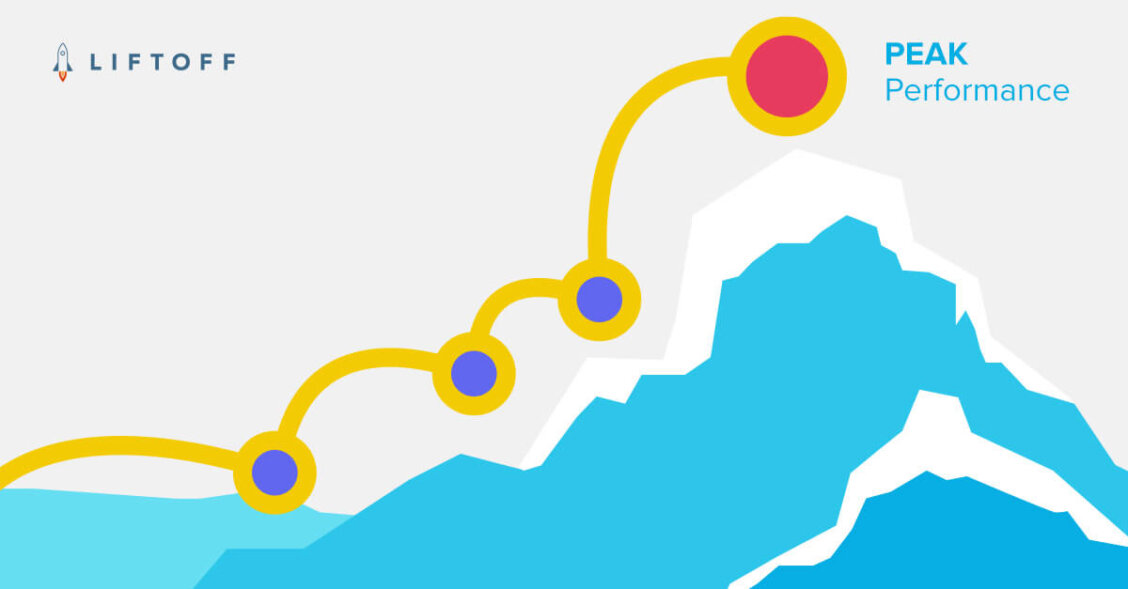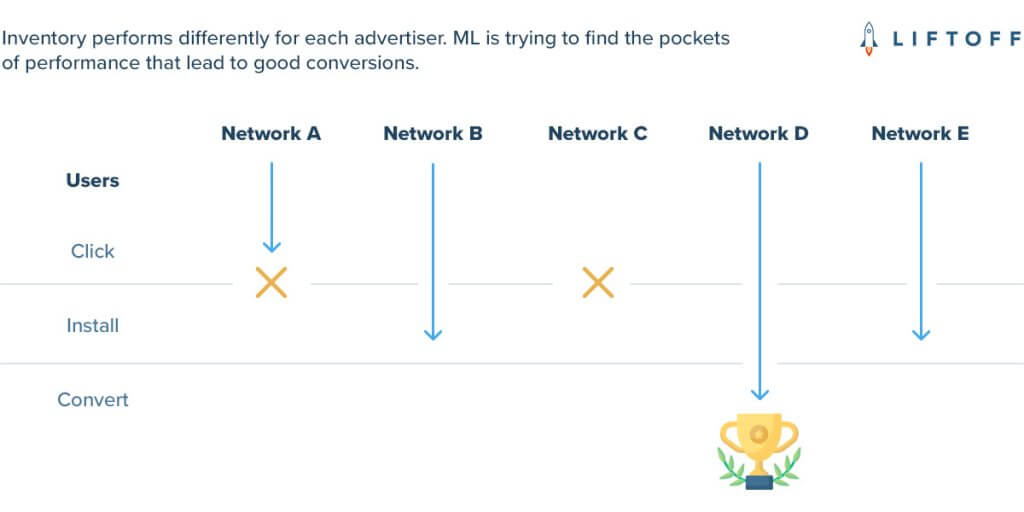
Explaining the Learning Phase
If you are starting a new campaign with Liftoff, you will go through a three-step process that helps your campaign maximize user engagement and revenue known as “Learn, Optimize, and Scale.”
The first of these, the learning phase, can be frustrating for even seasoned marketers—but it is necessary. Campaign success hinges on machine learning (ML) finding the right channels to work on, and it takes time for the bots to get up to speed. The window just after launching a programmatic campaign is when spend seems high while performance seems low, in what can feel like a never-ending waiting game.
Learning is a feature, not a bug, of demand-side platforms (DSPs). And this blog is here to help set expectations for marketers new to Liftoff’s capabilities by giving an in-depth view of the optimization phase and why it’s essential for every campaign to complete it.
What Is the Learning Phase?
Programmatic marketing channels rely on ML to make campaigns work, but ML requires data to be effective. At the launch of a new programmatic campaign, ML lacks that data to bid correctly. Faced with this conundrum, a programmatic partner needs to run campaigns on different channels to find the pockets of inventory where users convert. The process looks a little like this:

Greg Mansell, Client Partner at Liftoff, compares the process to “how a locksmith picks a lock.” ML taps a variety of channels to find the right combination that unlocks good performance. This process can take several weeks, depending on your partner. At Liftoff, we’ve introduced products that shorten the ramp-up time. Most optimizations take a certain number of event completions in order to work, though the ranges vary based on the model:
- For Cost per Install optimization: <100 installs
- For Cost per Action optimization: <300 unique events
- For Cost per Revenue optimization: <150 installs tied to revenue
Setting an expectation on how long the optimization will take, or how much it will cost, is misleading. As Greg says, timings differ “depending on the app, vertical, and geo.” In fact, “it’s not a question of how much time or how much money you have,” but it depends on your goals, setup, and integration.
The process may not satisfy every single goal. Jacinta Giancola, Ad Operations Manager at Liftoff, notes that while marketers might think they would see lower CPA and increased ROAS over time, it “can come at the cost of rising CPI.” ML will bid more to reach users that convert down the funnel: a worthy trade-off, though it can catch marketers by surprise.
What Can You Do To Reduce the Length of Liftoff’s Learning Phase?
Below we have collected five best practices to help shorten optimization with Liftoff and maximize our ML capabilities. If you’re starting up a new campaign with us, follow these steps to ensure easy onboarding.
Get Blocklisting Right
It’s common for advertisers to exclude publishers or users from their campaigns. However, this could create unwanted yet avoidable problems.
As Jacinta puts it, “we want our ML to be as unbiased as possible.” Picking favorites or excluding historic underperformers has the potential to miss out on valuable users. Furthermore, “limiting inventory increases cost—a DSP has to bid higher to find potential conversions.”
Make sure to limit the use of targeting restrictions. Don’t automatically begin a new campaign by targeting certain cities or regions because it reduces the available pool of inventory for ML to learn from.
It is helpful to send Liftoff an exclusion list of device IDs for users who have previously installed your app, but you want to balance their effects. “You may want to exclude users who have made a purchase previously,” adds Jacinta, “but there’s nothing to suggest they won’t purchase again through re-engagement.”
Finally, if your company is sensitive about data sharing, it’s also possible to send Liftoff a dynamic suppression list where the IDs are encrypted, depending on your mobile measurement partner (MMP).
Budget to Meet Minimum Daily Caps
Liftoff studies have shown that you need to reach a minimum daily spend to ramp up quickly. Those spend caps depend on your app, but Liftoff advises that it will be somewhere between $300 to $500 per day. This cost might seem high, but low spend will stop your campaign from performing as well as it can.
Set up Intermediary Events
“Intermediary events help us build towards your final goal like a stepping stone,” says Jacinta. Your final goal might be purchase, but if you also send Liftoff registration events, add to cart events, initiate purchase events, and any others you think are valuable, it will help optimize the funnel in the lead up to purchase.
Prepare Your Assets and Your Attribution Data
It is vital to have both your creatives and your attribution prepared at launch. Programmatic thrives on data, so make sure you are set up with an MMP and that you have all creative ad formats (from banners to video) along with visual assets and copy ready to go before running a campaign.
Send Liftoff Even More Data
Finally, it’s best to turn on view-through attribution and enable revenue postbacks. View-through is useful for measuring users who see but do not click an ad, even though they will install or make a purchase in the future. For revenue postbacks, Liftoff can use the data to optimize towards cost-per-revenue goals, which are more effective for some types of apps.
Going Where No App Has Gone Before
The learning phase is a tough but necessary step for marketing campaigns with programmatic partners. You have many options to reduce the time it takes to ramp up your campaign which will help in both the short and long term. Make sure to follow best practices, and reach out to Liftoff if you have any questions.
For more on programmatic best practices, keep an eye on the blog for new releases. You can also sign up to our mailing list to receive updates as they happen.